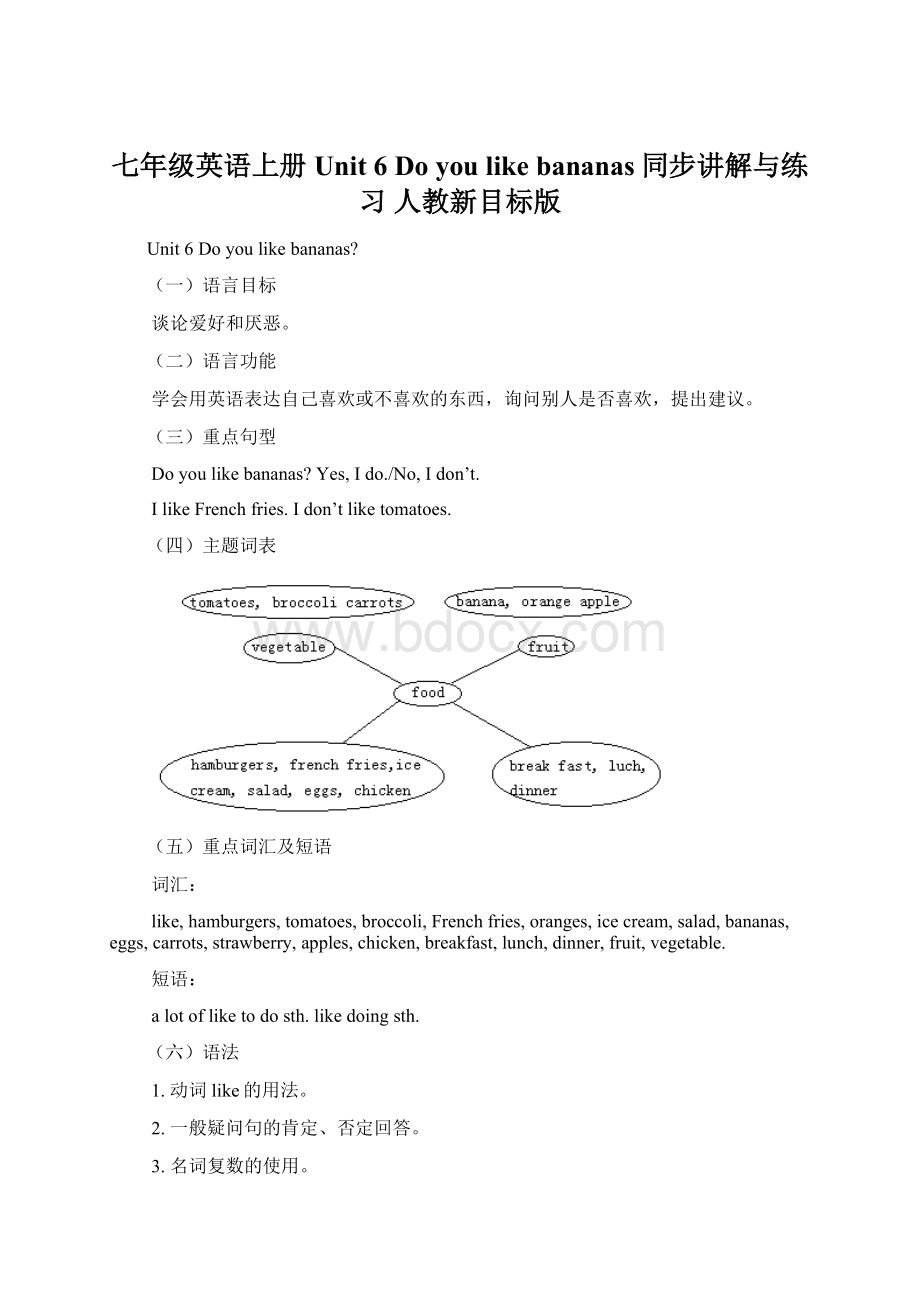 七年级英语上册 Unit 6Do you like bananas同步讲解与练习 人教新目标版Word文档下载推荐.docx
七年级英语上册 Unit 6Do you like bananas同步讲解与练习 人教新目标版Word文档下载推荐.docx
- 文档编号:18402849
- 上传时间:2022-12-16
- 格式:DOCX
- 页数:18
- 大小:85.58KB
七年级英语上册 Unit 6Do you like bananas同步讲解与练习 人教新目标版Word文档下载推荐.docx
《七年级英语上册 Unit 6Do you like bananas同步讲解与练习 人教新目标版Word文档下载推荐.docx》由会员分享,可在线阅读,更多相关《七年级英语上册 Unit 6Do you like bananas同步讲解与练习 人教新目标版Word文档下载推荐.docx(18页珍藏版)》请在冰豆网上搜索。

如:
banana-bananas
(2)以-o,-s,-sh,-ch及-x结尾的名词,在词尾加-es构成复数形式。
tomato-tomatoes
(3)有些以-o结尾的名词仍加-s。
photo-photos
(4)以辅音字母加-y结尾的名词,把-y去掉,加-ies。
family-families
(5)以-f或-fe结尾的名词,把-f,-fe去掉且加-ves。
life-lives
(6)有些名词以改变拼写来构成复数形式。
man-men
(7)有些名词单、复数相同。
sheep-sheep
3.lotsof大量的,许多的
lotsof在意思上与alotof相同,都表示“大量、许多”,但lotsof主要用于口语,两个都可以用来修饰可数名词和不可数名词,如:
Ihaven’tgotalotoftime.我们的时间不多了。
Therewaslotsofmoneyinthesafe.
保险箱中有许多钱。
4.Doyoulikebananas?
你喜欢香蕉吗?
Yes,Ido.是的,我喜欢。
(肯定回答)
No,Idon’t.不,我不喜欢。
(否定回答)
like是及物动词(vt.),意为“喜欢”“愿意”“想要”,后面可以加名词,代词宾客,动词不定式(to+v.原形)或动名词(v.-ing)作宾语。
例如:
Ilikethispicture.我喜欢这幅画。
(接名词作宾语)
Ilikeherverymuch.我非常喜欢她。
(接人称代词宾格作宾语)
Theyliketogowithus.他们喜欢和我们一起去。
(接v.不定式作宾语)
Helikesreadinginbed.他喜欢躺在床上看书。
(接v.-ing作宾语)
谓语动词为like(s)的一般现在时句式,变否定句要借助助动词do(does)not组成。
Idon’tlikethispicture.
Hedoesn’tlikereadinginbed.(注意like不再加-s)
谓语动词为like(s)的一般现在时句式,变疑问句时,也要用助动词do(does),即在句首加Do(Does),句末用问号,回答时用Yes或No。
Doyoulikesalad?
Yes,Ido./No,Idon’t.
Doeshelikeicecream?
Yes,hedoes./No,hedoesn’t.
你知道什么时候用do,什么时候用does吗?
当主语为非单数第三人称时,用助动词do。
当主语为单数第三人称时,用助动词does。
(does是do的单数第三人称形式)
5.主语为第三人称单数时一般现在时的结构
肯定式:
主语+谓语v.的单数第三人称形式+其他,如:
Helikesbananasalot.他非常喜欢吃香蕉。
否定式:
主语+助动词(doesn’t)+动词原形+其他。
如:
Hedoesn’tlikebananas.他不喜欢吃香蕉。
疑问式:
助动词(Does)+主语+动词原形+其他。
肯定回答:
Yes,主语+does。
否定回答:
No,主语+doesn’t。
DoesKatelikemeat?
凯特喜欢吃肉吗?
Yes,shedoes.是的,她喜欢。
No,shedoesn’t.不,她不喜欢。
6.breakfast的用法
(1)泛指“早饭”,前面不加冠词,例如:
Atwhattimedoyouhavebreakfast?
你什么时候吃早点?
Chinesehaveporridge(粥)forbreakfast.
中国人早饭吃粥。
(2)如果breakfast有修饰词,前面通常加不定冠词“a”。
Hehadaquickbreakfastthismorning.
他今天早餐吃得很快。
拓展:
atbreakfast吃早饭时
beforebreakfast早饭前
afterbreakfast早饭后
(3)havesth.forbreakfast.早餐吃……
注:
以上用法通用于lunch和supper,另外“吃早(午,晚)餐”常用havebreakfast/lunch/supper。
7.likedoing与liketodo
两者意思差不多,都是“喜欢做某事”的意思,但也有差别:
likedoing指习惯性的兴趣爱好;
liketodo指某一特定的动作。
例如:
Ilikereading.ButIdon’tliketoreadnow.
8.fish作可数/不可数名词的用法
fish可以作不可数名词,表示吃的“鱼肉”,没有复数形式;
fish也可以作可数名词,表示“鱼”,复数形式为原形,但也可以加-es,表示不同种类的“鱼”,例如:
Ilikeeatingfish(fish指“鱼肉”).
Icatch(抓)manyfish(fish指“鱼”,复数为原形).
Icatchthreefishes(fishes指三种鱼).
9.like用法小结
(1)like作介词,表示“像……一样”。
Youarelikeyourfather.你长得像你爸爸。
Lucy’shatlookslikemycat.
Lucy的帽子看起来像我的猫。
其中belike=looklike。
(2)like作动词,表示“喜欢”。
like作动词时,其主要用法如下:
①likesth.(like接名词或人称代词宾格)如:
Ilikebananasverymuch.我非常喜欢香蕉。
Mymotherisveryclever.Ilikehimverymuch.
为什么不用he呢?
我的弟弟非常聪明,我非常喜欢他。
②like+doingsth.如:
Mybrotherlikesswimming,butIlikesinging.
③liketodosth.如:
Helikestocooknow.
④likesb.todosth.
Idon’tlikehimtoeatlikethat.
⑤like…alot=like…verymuch非常喜欢。
Ilikemymotheralot.
Mybrotherlikesrunningverymuch.
⑥like…alittle有点喜欢。
—Doyoulikebasketball?
—Yes,Ilikeitalittle.
10.动词be和动词do
至目前我们已学过的动词中,出现了两种不同的动词作谓语,一种是动词be,另一种是动词do(即实义动词)。
动词be不表示一个具体的动作,中文意思是“是”或“在”;
动词do则表示一个比较具体的行为动作或心理活动,如:
work,find,love,play,know,like等。
在陈述句中,它们都根据主语人称和数的不同用不同的形式。
△动词be有am,is,are等不同形式,am用于主语为第一人称单数;
is用于主语为第三人称单数he,she,it及其他单数或不可数名词,are用于主语为复数第一、二、三人称we,you,they及其他复数名词。
△动词do有do/does等形式,当主语为非单数第三人称时,用原形;
当主语为单数第三人称时,用does。
△动词be的否定式是在be后加not,疑问式是把be放在主语前面。
—I’maboy.I’mnotagirl.Areyouagirl?
我是一个男孩。
我不是一个女孩。
你是一个女孩吗?
—Isyourhomenearyourschool?
—Yes,itis.
你家在你们学校附近吗?
是的。
△动词do的否定式及疑问式要借助于助动词do/does来构成。
下面以work为例,请分析并归纳表中动词work在肯定句、疑问句及否定句中的变化情况。
肯
定
句
I/We/You/They/workhere.
Mybrotherandsisterworkhere.
ThetwoAmericansworkhere.
He/She/Itworkshere.
Maryworkshere.
疑问句及回答
Doyou/theyworkhere?
Doyourbrotherandsisterworkhere?
DothetwoAmericansworkhere?
Doeshe/she/itworkhere?
DoesMaryworkhere?
Yes,I/wedo.
No,I/wedon’t.
Yes,theydo.
No,theydon’t
Yes,he/she/itdoes.
No,he/she/itdoesn’t
否定句
I/We/You/Theydon’tworkhere.
Mybrotherandsisterdon’tworkhere.
ThetwoAmericansdon’tworkhere.
He/She/Itdoesn’tworkhere.
Marydoesn’tworkhere.
(八)考题分析
[考题1]用a,an,some完成下列短语。
(1)___________hamburgers
(2)____________cake
(3)____________tomato
(4)____________orange
(5)____________egg
(6)____________salad
解析:
本题考查要点1中可数名词用法,可数名词前可以加a,an限定。
答案:
(1)some
(2)a(3)a(4)an(5)an(6)a
[考题2]写出下列名词的复数形式。
knife_____________woman_____________
people_____________radio_____________
potato_____________sheep_____________
box_____________watch_____________
apple_____________baby_____________
knives,women,people,radios,potatoes,sheep,boxes,watches,apples,babies
[考题3]Ihave_____________friendsinWuhan.
A.muchB.alotsofC.lotsofD.alot
此题是辨析表示“许多”的几种说法的区别。
much修饰不可数名词,alotof=lotsof都是修饰可数名词,因此本题选C。
C
[考题4]连接问题与回答:
(1)DoyoulikeFrenchfries?
(2)Doesshelikebananas?
(3)Doeshelikeoranges?
(4)Dotheyliketomatoes?
(5)Whatdoyouliketoeat?
a.Ilikehamburgers.
b.No,hedoesn’t.
c.Yes,shedoes.
d.Yes,Ido.
e.No,theydon’t.
此题考查要点4中like的一般现在时疑问句的回答。
(1)d,
(2)c,(3)b,(4)e,(5)a
[考题5]
(1)She_____________oranges,butshe_____________apples.
A.like,don’tlikeB.likes,doesn’tlikes
C.likes,doesn’tlikeD.likes,don’tlike
(2)_____________he_____________acomputer?
A.Does,hasB.Does,have
C.Do,haveD.Is,having
(1)本题考查主语为单数第三人称时一般现在时的肯定式和否定式结构。
注意加助动词doesn’t后,like用原形。
(2)本题考查一般现在时主语为单数第三人称时,一般疑问句的结构。
(1)C
(2)B
[考题6]
(1)Ioften_____________supperbefore7:
00.
A.haveB.eatC.haveaD.havethe
(2)TodayisMid-AutumnDay.Wehave_____________lunch.
A.abigB.alight
C.bigD.thebig
(1)句意为“我经常在七点以前吃晚饭。
”吃早/中/晚饭,英语里用havebreakfast/lunch/supper来表达。
不用eat,也不能带冠词a/an/the。
(2)句意为“今天是中秋节,我们吃了一顿_____________午餐。
”haveabiglunch表示吃了一顿丰盛的午餐,havealightlunch表示吃了少量的午餐。
(1)A
(2)A
[考题7]Doyoulike_____________footballafterclass?
A.toplaytoB.playing
C.toplayD.plays
本题是问“下课后你喜欢踢足球吗?
”,是指某一特定动作,故用liketodosth.句型,且踢足球是“playfootball”。
[考题8]Ilikeeating_____________.Mumbuystwo_____________forlunch.
A.fish,fishB.fish,fishes
C.fishes,fishesD.fish,fishs
句意为“我喜欢吃鱼,妈妈为午餐买了两条鱼”。
前一个fish指“鱼肉”,为不可数名词,后一个“fish”为可数名词,指“鱼”,复数为原形。
A
[考题9]
(1)I_____________mymotherandI_____________herverymuch.
A.like,likeB.amlike,likes
C.looklike,amlikeD.amlike,like
(2)假设你是Kate,看下面的表格,
是非常喜欢,
为有点喜欢,
为根本不喜欢,写出表中所列内容。
Name
hamburgers
tomatoes
apples
Kate
Tom
Paul
Idon’tlike________________________________________________________________
_________________________________________________________________________________________________________________________________________________________________________________________________________________________________________
(1)句意为“我像我的妈妈,并且我非常喜欢她。
”前一个like为介词,用belike/looklike作谓语,后一个like为动词,主语为非单数第三人称,用原形作谓语。
(2)本题考查了本单元重点语言目标——谈论喜欢和不喜欢,其中综合运用了要点4、5中主语为单数第三人称时,肯定句式和否定句式的用法,并且还考查了学生动手书写的能力。
(1)D
(2)Idon’tlikehamburgersatall.ButIlikeapplesalittle.MyfriendTomlikestomatoesalittleandhelikesapplesverymuch.MyfriendPaullikeshamburgersalot,buthedoesn’tlikeapplesatall.
[考题10]
(1)情景反应。
从B栏中找出与A栏中相对的答语。
A
①Doesherfatherlikeoranges?
②Doesyoursisterlikeicecream?
③Whatdoyouliketohaveforlunch?
④Doyoulikeabroccoli?
⑤Dotheylikevegetables?
⑥Wherearetheapples?
⑦Isthetomatogreen?
⑧Whatcoloristhebanana?
B
A:
Yes,Ido.
B:
No,itisn’t.It’sred.
C:
Inthebasket.
D:
No,theydon’t.
E:
No,hedoesn’t.
F:
It’syellow.
G:
IlikeFrenchfries.
H:
Yes,shedoes.Shelikesitverymuch.
(2)连词成句,注意字母大小写及标点符号:
①those,are,in,what,English(疑问句)
________________________________________________________
②he,like,does,hamburgers(疑问句)
③they,a,have,do,computer(疑问句)
④do,like,not,they,icecream(陈述句)
⑤is,friend,Gina,my,this(陈述句)
(1)本题中以连线形式考查了动词be和do的疑问句式及其回答。
(2)本题以连词成句形式考查了动词be和do的陈述句式和疑问句式。
(1)①E,②H,③G,④A,⑤D,⑥C,⑦B,⑧F
(2)①WhatarethoseinEnglish?
②Doeshelikehamburgers?
③Dotheyhaveacomputer?
④Theydon’tlikeicecream.
⑤Thisismyfriend,Gina.
【模拟试题】
(答题时间:
70分钟)
I.请根据语境,将所给单词填入下列各句。
(5分)
A.applesB.breakfastC.carrots
D.hamburgersE.broccoliD.dinner
G.potatoesH.orangesI.salad
J.Frenchfries
1.Tomlikesfruit,sohelikes__________and__________.
2.—Whatvegetablesdoyoulike?
—Ilike__________,__________and__________.
3.Iusuallydrinkmilkfor__________and__________.
4.—Doyoulikewesternfood?
—Yes,Ilike__________,__________and__________.
I
- 配套讲稿:
如PPT文件的首页显示word图标,表示该PPT已包含配套word讲稿。双击word图标可打开word文档。
- 特殊限制:
部分文档作品中含有的国旗、国徽等图片,仅作为作品整体效果示例展示,禁止商用。设计者仅对作品中独创性部分享有著作权。
- 关 键 词:
- 七年级英语上册 Unit Do you like bananas同步讲解与练习 人教新目标版 年级 英语 上册 bananas 同步 讲解 练习 新目标
 冰豆网所有资源均是用户自行上传分享,仅供网友学习交流,未经上传用户书面授权,请勿作他用。
冰豆网所有资源均是用户自行上传分享,仅供网友学习交流,未经上传用户书面授权,请勿作他用。
链接地址:https://www.bdocx.com/doc/18402849.html


 转基因粮食的危害资料摘编Word下载.docx
转基因粮食的危害资料摘编Word下载.docx
